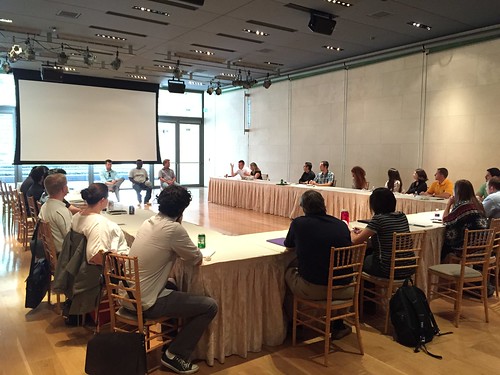The June session of the 2015 AIA
Emerging Leaders Program was held at the Steelcase Worklife Center in the
Design District of Dallas.
For our panel discussion we invited
three distinguished professionals to engage in a lively discussion and respond
to questions concerning the topic of mentorship: Tip Housewright, FAIA,
President of OMNIPLAN; Jim Henry, AIA, a Design Director and AVP of HDR; and
Robert Rogers, P.E., a Structural
Engineering Project Manager at Thornton Tomasetti. Tip has served as President
of the AIA Dallas and the Dallas Center for Architecture as well as serving on
numerous committees of the Texas Society of Architects. Jim has served on the
AIA Dallas Board and Design Awards Committee and was awarded a 2015 Young
Architects Award by the AIA. Robert is active as a leader with both
Toastmasters International and the ACE Mentor DFW Program and has delivered
keynote addresses on the topics of leadership and career success for both
organizations.
We started the panel discussion by
asking each guest to describe their experience with mentorship and how it is
conducted within their organizations. Tip explained that his experience has
been informal, but always deliberate. While OMNIPLAN does not have a formal
mentorship program that pairs mentors with protégés, Tip encourages his staff
to serve as mentors and to seek mentors. Jim related that his experience has
also been more organic than formal. He went on to explain that while mentorship
occurs casually at HDR, as it does everywhere, the firm also has a formal
program that pairs people across the organization, often in different offices.
Robert related his experience engaging in Toastmasters International and then
in the ACE Mentor DFW program. The ACE Mentor program provides an opportunity
for professionals in the architecture, construction and engineering fields to
educate and serve as mentors to high school students interested in pursuing a
career in these fields. Throughout the discussion, all three guests stressed
the importance of treating a mentorship experience with respect as a
relationship, that it can change lives for the better. It can lead to
professional and personal development. It's a two-way street. Both participants
need to be committed and sincere. They need to be honest and empathetic, make
expectations clear, get to know each other, be accountable, and sometimes make
sacrifices in their use of time. It takes effort to make the most of the
experience. While it can be difficult to engage in a mentoring relationship
outside of your firm or field of practice, all three guests agreed that those
can be very rewarding as well. Tip noted that clients can be great mentors.
Involvement in the AIA and other business and community organizations can lead
to significant mentorship opportunities.
After a brief discussion of the class
project we made our way over to nearby Rodeo Goat Ice House to partake of tasty
beverages and good conversation.




